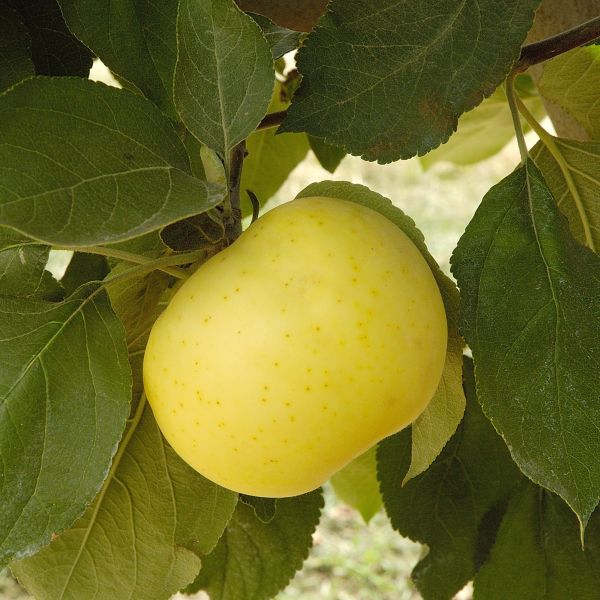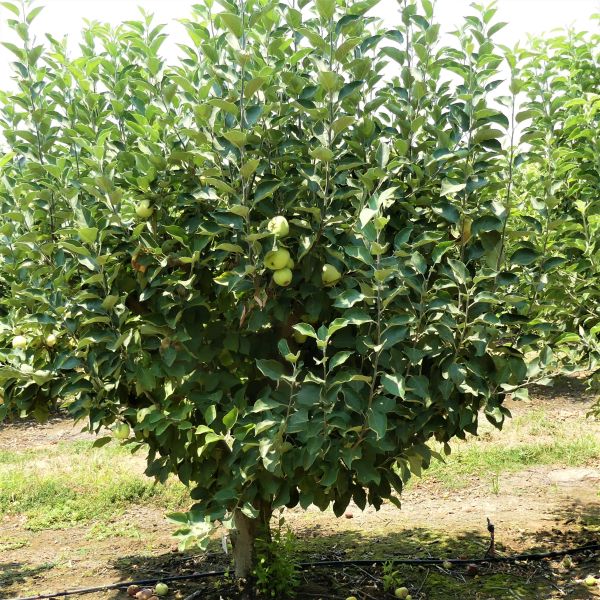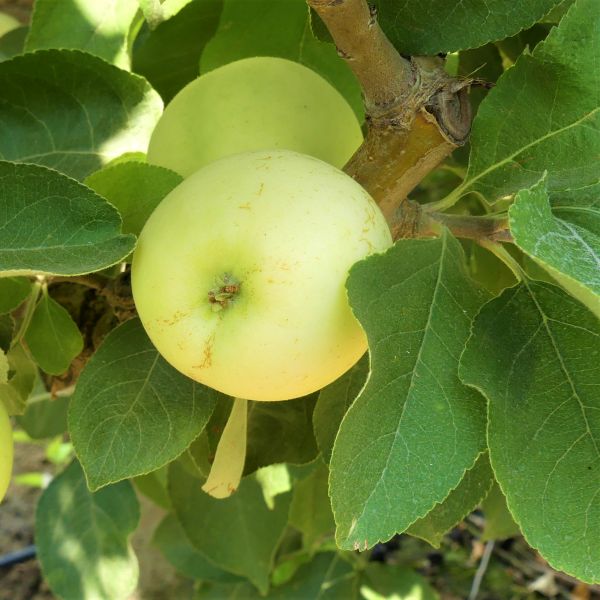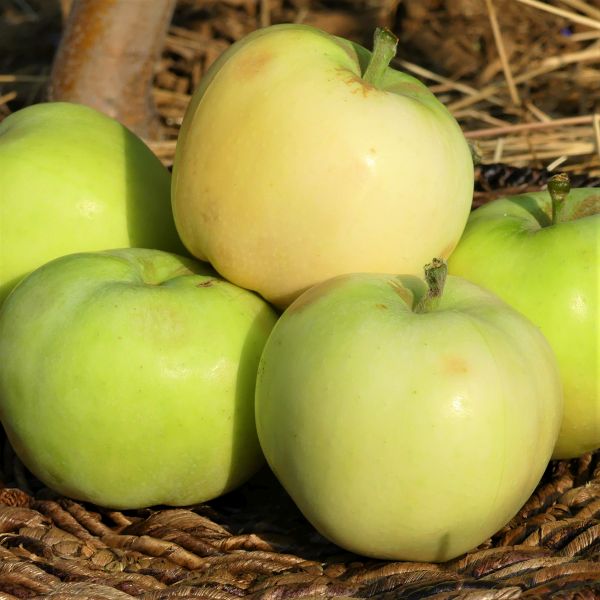Yellow Transparent Apple Trees
Malus 'Yellow Transparent'
Plant Sentry™
Plant Sentry™

Plant Sentry™ Protected
Your order is protected by our compliance system that:
- Prevents restricted plants from shipping to your state
- Ensures plants meet your state's agricultural requirements
- Protects gardens from invasive pests and diseases
Delivery and Shipping
Delivery and Shipping
Delivery and Shipping
Fast, Safe Plant Delivery
Ships in 3-4 business days • Tracking provided • Weather protected
| Under $50 | $9.99 |
| $50 - $99.99 | $14.99 |
| $100 - $149.99 | $16.99 |
| $150 - $198.99 | $24.99 |
| $199+ | FREE |
✓ Zone-specific timing • ✓ Professional packaging • ✓ Health guarantee
Understanding Plant Options
Nature Hills offers plants in two main formats:
- Container Plants: Grown in pots with soil, sized by container volume and plant age
- Bare Root Plants: Dormant plants without soil, sized by height measurements
Container Plant Sizes
Container sizes indicate plant age and growing capacity rather than liquid volume equivalents. Our containers follow industry-standard nursery "trade gallon" specifications, which differ from standard liquid gallon measurements.
Young Plants (6 months to 18 months old)
| Container Size | Actual Volume | Metric Equivalent |
|---|---|---|
| 2" x 2" x 3" | 0.18 - 0.21 dry quarts | 0.20 - 0.23 dry liters |
| 4" Container | 0.31 - 0.87 dry quarts | 0.35 - 0.96 dry liters |
| 4.5" Container | 0.65 dry quarts | 0.72 dry liters |
| 6" Container | 1.4 dry quarts | 1.59 dry liters |
| 1 Quart | 1 dry quart | 1.1 dry liters |
| 5.5" Container | 1.89 dry quarts | 2.08 dry liters |
Established Plants (18 months to 2.5 years old)
| Container Size | Actual Volume | Metric Equivalent |
|---|---|---|
| 2 Quart | 2 dry quarts | 2.2 dry liters |
| #1 Container | 2.26 - 3.73 dry quarts | 2.49 - 4.11 dry liters |
| 5" x 5" x 12" | 3.5 - 4.3 dry quarts | 3.85 - 4.74 dry liters |
Mature Plants (2-4 years old)
| Container Size | Actual Volume | Metric Equivalent |
|---|---|---|
| #2 Container | 1.19 - 1.76 dry gallons | 5.24 - 7.75 dry liters |
| #3 Container | 2.15 - 2.76 dry gallons | 8.14 - 12.16 dry liters |
Large Plants (3-5 years old)
| Container Size | Actual Volume | Metric Equivalent |
|---|---|---|
| #5 Container | 2.92 - 4.62 dry gallons | 12.86 - 20.35 dry liters |
| #6 Container | 5.25 - 6.01 dry gallons | 23.12 - 26.42 dry liters |
| #7 Container | 5.98 - 6.53 dry gallons | 26.34 - 28.76 dry liters |
Bare Root Plants
Bare root plants are sold by height from the root system to the top of the plant. Plants may exceed minimum height requirements.
Common Sizes:
- Trees: 1 foot, 2 feet, 3 feet, 4 feet, 5 feet, 6 feet
- Shrubs & Perennials: 1 foot, 18 inches, 2 feet
Important Notes
Container Volume Specifications
- Trade Gallon Standard: Our containers follow industry-standard "trade gallon" specifications established by the American National Standards Institute (ANSI Z60.1) for nursery stock
- Volume Variations: Actual soil volume may vary due to plant root systems and growing medium settlement
- Age Indicators: Container size primarily indicates plant age and maturity rather than liquid volume equivalents
Growing Conditions
- Plant size can vary based on variety and growing conditions
- Container size helps indicate plant maturity and establishment level
- Larger containers generally mean more established root systems and faster landscape establishment
Seasonal Availability
- Bare root plants are available seasonally when dormant
- Container plants are available throughout the growing season
- Specific varieties may have limited availability in certain sizes
Questions?
For questions about specific plant sizes or availability, please contact our plant experts who can help you choose the right size for your landscape needs.

Plant Sentry™ Protected
Your order is protected by our compliance system that:
- Prevents restricted plants from shipping to your state
- Ensures plants meet your state's agricultural requirements
- Protects gardens from invasive pests and diseases
Plant Profile & Growing Essentials
Cold hardy, Flowering, Edible, Ornamental Berries/Fruit, and Attracts pollinators
Specifications
Specifications
-
Botanical Name
-
Height
-
Width
-
Growing Zones
-
Sunlight
-
Growth RateModerate
-
Flower Color
-
Leaf Color
-
Fall Color
-
Pollinator FriendlyYes
-
Pollinator Required
-
Bloom PeriodEarly Spring
Planting & Care Instructions
Planting & Care Instructions
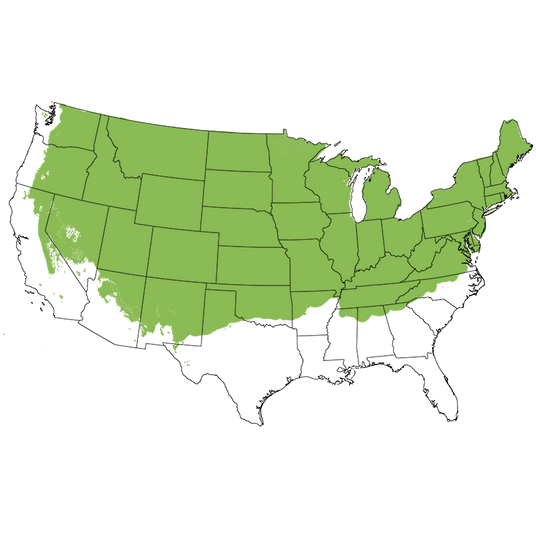
Growing Zones 2-7
Cold-Hardy, Early Harvest Yellow Transparent Apple Tree!
Your favorite baked goods will receive high marks when you use the creamy-white and tender Yellow Transparent Apples! Just imagine creamy white applesauce and apple butter!
Yellow Transparent (Malus 'Yellow Transparent') is a deciduous, fruit tree that originates from Russia in 1870 and is now widely grown in the northern states because of its early summer apples, some of the earliest ripening apples available!
Featuring a unique, delightfully yellow-hued bark, and lush, green foliage.
Pollinators are grateful for the early display of pink or white flowers and their nectar resource. You'll adore the display as a welcome break from the winter doldrums.
It's not long before the apples follow, with their skin a clear, pale yellow that's greenish, yellow to nearly white.
The flesh of the Yellow Transparent Apple is tender white on the inside, with a juicy and mildly acidic flavor that makes it a favorite for homemade applesauce and other culinary delights such as juice, cider, and other baked goodies!
How to Use Yellow Transparent Apple Tree In The Landscape
Yellow Transparent provides an early harvest, with the apples ripening as early as July! Meaning it is a fantastic choice for northern gardeners! One of the Yellow Transparent's prized features is that it's very cold-hardy (thus a favorite in northern climates).
Smaller form and upright growth make these space-saving trees are great for smaller gardeners as well! The Yellow Transparent Apple Tree is a very upright, precocious, and productive tree. Therefore, it's also a heavy producer!
For an extended season of harvest, plant amid other, late-maturity varieties. You can harvest the apples at their peak or pick some before maturity for better storage life.
Plant one in your backyard where it will be visible from a patio or window so you can enjoy the spring display and watching your harvest grow.
Sized perfectly for urban and city gardening, as well as specimen and focal point plantings for dual-purpose and edible landscaping!
Plant as an accent or anchor in larger plantings among other smaller trees, shrubs and perennials for a long season of blossoms!
Because Yellow Transparent isn't completely self-fruitful, you will have far larger harvests when you plant it with one of its pollination partners. Any white flowering Crabapple or pick from the selection below in the FAQ. If you don't have room for two trees, you can try high density planting techniques or get with a neighbor and plant Apple trees together to boost yield and share in the harvest!
- Excellent Pale Yellow-Skinned Fruit
- White Flesh & Tender - Juicy Mildly Acidic Flavor
- Fragrant Pink & White Blossoms
- Nectar Resource for Pollinators!
- Vigorous Growth -Lush Foliage & Upright Form
- Unique Yellow Bark
- Early Heavy Producer - Harvest as Early as July!
- Creamy White Applesauce - Freezing, Drying, Juice & Cider!
#ProPlantTips For Care
Fruit trees like Apples require full sun for the best fruit and bloom! Be sure to provide your tree at least 8 hours of direct sunlight.
Best in organically rich, fertile, and well-drained soil, amend with compost for more fertility and raise the planting level if drainage is an issue.
For best harvests and the juiciest apples, be sure to provide your tree with a consistent watering schedule and do not allow them to go long in drought.
While drought-tolerant once established, protect your investment with regular waterings in times of need.
A generous layer of mulch helps retain soil moisture as well as insulate the root system from heat and chill.
Prune in late winter when dormant to open the crown for air circulation and to allow sunlight into the interior.
Yellow Transparent is a scab-resistant Apple variety as well and is considered relatively disease-resistant!
- Full Sun For The Most Fruit
- Most Rich Well-Drained Soils
- Regular Moderate Moisture Needs
- Partially Self-Fruitful - More Fruit With Pollination Partner
- Extreme Cold Hardiness!
- Easy Care & Low Maintenance
- 800-1000 Chill Hours
You can’t go wrong with a Yellow Transparent Apple Tree in your yard, especially if you live in a northern locale. It's a lovely tree that will provide you with delicious fruit early in the season for years to come.
Order yours from Nature Hills while they last!
When to Plant Yellow Transparent Apple Trees
Planting Bareroot trees as soon as you can dig a hole in spring and until hot weather, the earlier the better. Plant container Apple trees throughout the growing season with complete success - that is the benefit of container plants - to extend the planting season. Your County Agricultural Extension Office is a great resource for first and last frost dates in your area.
How to Plant Yellow Transparent Apple Trees
Dig a large hole only as deep as needed to accommodate the bareroot or container root ball, and twice as wide. Add Nature Hills Root Booster to speed root establishment. Remove the pot or bag and situate it into the hole so the top of the soil (soil line if bareroot), is level with the new location's soil being careful not to plant too deep. Water in again very well and backfill with the same soil you dug up, tamping down gently to ensure there are no air pockets.
Top off with a 3-4 inch thick layer of Arborist mulch. Consider staking your tree to keep its trunk growing straight for the first year to ensure it stands tall against strong winds and drifting snow.
When to Prune Yellow Transparent Apple Trees
Trim off any broken branches from delivery as soon as you take them out of the box. Prune and trim Apple trees while dormant, in late winter or early spring, before you see new growth.
How to Prune Yellow Transparent Apple Trees
Dormant prune to:
- Remove any double leaders or narrow crotch angles
- Eliminate any crossing branches
- Thin interior branching, leaving the fruiting spurs and strong branches in place opening up the canopy
- Branching at least 24-36 inches above the ground
Prune Apple trees in the summer to:
- Control size and shape by reducing the length of longer new growth on vigorous trees
- Remove water sprouts on the main trunk or older branches in the crown
- Remove suckers at the base of the trunk
- Thin fruit during heavy years on established trees
How to Care for Yellow Transparent Apple Trees
Growing an Apple tree is easy when proper soil, good drainage, attention to moisture, and regular fertility are maintained. Once you've chosen an apple tree that works for your climate, in the size you need for your landscape, and its pollinator (if needed), then you've accomplished half the battle!
- Apple trees do best in full sun and well-drained soil
- Water your apple trees when it get dry - especially during the fruit production stage, and drought periods to keep it stress-free
- Use arborists' wood chips to mulch over the roots of your apples and have your soil tested to see what your soil may be lacking before adding fertilizers
- Maintenance pruning and shaping
Apple trees will tolerate a wide range of soils, so long as water and nutrients are not limited and the pH level is adequate.
How to Fertilize Yellow Transparent Apple Trees
For the first year, water alone is most important. It is always best to get a soil test to see what your soil is lacking before adding more fertilizers. Once established, a fertilizer routine may be beneficial. We do offer some excellent slow-release organic options, applied according to the package directions.
Fruit trees need more phosphate and it's possible to apply too much nitrogen which affects the soil's pH. Test soil acidity or alkalinity using a pH Tester.
Fertilize in spring when you first see new growth emerging.
- Don't overdo it
- Phosphates are your friends
- Pay attention to pH in areas with extremely high or low soil pH
- Follow the directions
Yellow Transparent Apple Tree Pollinating Info
Yellow Transparent is partially self-fruiting and needs a pollinating partner. Pair with any of these Apple varieties to improve fruiting:
- Any White Flowering Crabapple such as Centennial, Chestnut, or Dolgo Crabapples
- Cortland
- CrimsonCrisp
- Cripps Pink or Red
- Discovery
- Empire
- Freedom
- Frostbite
- Fuji
- Granny Smith
- Haralson
- Jonathan
- McIntosh
- SunCrisp
- Sweet Sixteen
- Wealthy
- Wolf River
- Zestar
Harvest Times for Yellow Transparent Apple Trees
Yellow Transparent Apples are typically ready to harvest in late June and July, therefore considered an early-season Apple Tree.
Early-Season? Mid-Season? Late-Season? The terminology can be confusing for new apple tree growers. Weather, climate and your tree determine when it's ripe.
For Apples:
- Early-season is usually June-July
- Mid-season can be August-September
- Late-season can be from late September-November
The growing season consists of spring, summer, and fall, and varies with climate and weather. Areas with longer growing seasons in the warmer hardiness zones can greatly affect the harvest times for each particular apple variety grown in your area.

